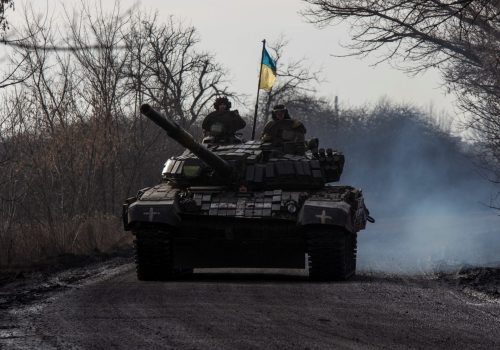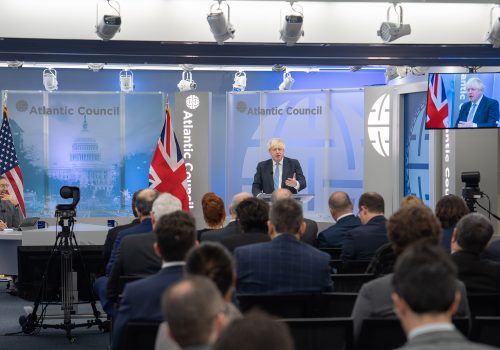Policymakers: Keep Ukrainian soldiers front of mind as this war of attrition continues
Ukraine is succeeding in this conflict; but it’s coming at an extremely high cost in terms of casualties and suffering. Continued Western support is critical to navigating these attritional losses because Ukrainian mettle without Western metal can only go so far. But at this moment of reflection, it is important to not lose sight of the perspective of the soldiers in the field with dirt and blood on their uniforms: They’re more concerned about when they’ll get their next ammunition resupply, hot meal, or break from taking fire than they are interested in contemplating what happens when the war is over. There is no doubt that Ukraine is winning this war, but that does not mean the war has been won.
Russia’s brazen invasion has brought the harsh realities of attritional warfare to Ukraine. This war is being fought by humans—humans engaged in violent armed conflict. At every stage of the war, Ukrainian forces—with strong Western support—have valiantly outperformed the Russian military, not only by defending their homeland but also by executing sizeable offensive operations to retake previously seized areas. Ukrainian successes, coupled with frequent and often incompetent Russian failures, have fueled significant enthusiasm for Kyiv to not only expel Russian invaders from the areas seized since February 2022 but also potentially go further and reclaim Crimea. Social media is rife with content mocking Russian performance or celebrating Ukrainian successes; that can give the appearance of a lopsided war in which the Armed Forces of Ukraine are enduring relatively smaller costs compared to their Russian adversaries—but the costs are, in fact, enormous.
Social media… can give the appearance of a lopsided war in which the Armed Forces of Ukraine are enduring relatively smaller costs compared to their Russian adversaries—but the costs are, in fact, enormous.
On this one-year anniversary, there will be countless articles chock-full of analysis on how this war has played out and predictions on the way forward. Military jargon such as “long-range precision fires” and “combined arms maneuver” will be thrown around, and analysts will speak to the challenges of maintaining ground lines of communication or protecting critical infrastructure and key resources. While this analysis is rich and well-informed, the language sterilizes reality. From my experience in combat, there is no sterilization of battle; language cannot conceal the realities of violent armed conflict. In plain speak, Ukraine is engaged in a brutal battle with Russia, primarily through the exchange of long-range heavy-weapons fire, that is playing out in towns and cities across Ukraine. This is coupled with Russia’s systematic bombardment of Ukrainian civilian power, water, and communications infrastructure in major cities such as Kyiv. Troops on both sides of the conflict are hunkering down in World War I-style trenches and attempting to maneuver on each other—before, during, or after massive volleys of artillery rounds—in increasingly harsh conditions, all the while searching for adequate food, water, medical supplies, or ammunition. The net result is carnage on a massive scale.
The dwindling supplies of ammunition reserves call attention to other devastating effects of artillery warfare. Artillery rounds can be fired from long ranges, often accompanied by a distant, audible boom. But for those on the receiving end, when and where those rounds will impact can be a mystery. Incoming artillery shells produce a sound akin to a whistle, which can only be heard when they overshoot their intended target and the round goes over your head—meaning the rounds that make the desired impact are heard too late. With the massive volume of artillery rounds fired each day, the soldiers on the battlefield are becoming tragically tuned into the pitch of rounds hitting nearby, air burst rounds exploding above, shrapnel scattering in the air, or razor-sharp flechette rounds detonating.
While, according to US officials, Russia’s rate of fire has decreased 75 percent in comparison to its wartime high, this isn’t likely to be overly celebrated by the soldier on the battlefield, given that at least five thousand rounds still fall each day and put soldiers’ lives at risk.
There is much discussion about how the West can provide more ammunition to Ukraine, given how critical artillery has been in this war. Yet that analysis doesn’t always explore how some soldiers are likely to suffer from neurological effects due to repeated blast exposure as they continue to face artillery-fire rates that rival those seen during the Korean War. As one of the thousands of US service members who have endured concussive events in combat, I can attest that the consequences can be difficult to diagnose and often don’t emerge in immediate or obvious ways. That isn’t to say that more ammunition and support are not desperately needed by Ukraine, nor that Western support is not critical. Rather, amid all the defense-speak, officials and experts should look beyond the curtain of sterilized, technical analysis and discuss what attritional warfare means for those executing it on the battlefield.
Amid all the defense-speak, officials and experts should look beyond the curtain of sterilized, technical analysis and discuss what attritional warfare means for those executing it on the battlefield.
Even the term “attritional warfare” itself veils its true meaning. Often described as a military strategy, attritional warfare aims to break an enemy’s will to fight by killing or wounding its soldiers and destroying or damaging the enemy’s materiel to a point that it can no longer sustain the war. Opposing militaries must “reconstitute,” which is officially defined as taking actions “to restore degraded units to combat effectiveness commensurate with mission requirements and available resources.” But in the combat soldier’s lexicon, reconstitution means undertaking the gruesome activity of replacing dead or wounded soldiers and destroyed or broken equipment.
The amount of destruction in this war is enormous. The United States estimated back in November that the Ukrainian military has sustained over one hundred thousand casualties (which includes both dead and wounded). Given the intensity of recent fighting in the Donbas centered around Bakhmut, the casualty count is certainly higher. Put into context, the Ukrainian military has had more casualties in this war than the US military has sustained in the nearly fifty years since the end of the Vietnam War. Reconstituting major portions of the front-line force is an unbelievably challenging task, which probably speaks to Ukraine and Russia’s determination to prevent each other from doing just that. Both sides fear the other will regain strength over the winter by remaining in a defensive posture and then launch major offensive operations in the spring. These tactics may ultimately delay or deny both sides the ability to reconstitute sufficiently.
Then there is the politics of warfare, which is also impacting soldiers on the ground. Much of this is playing out around Bakhmut. The fighting in this area has been furious for months, involving both Ukrainian and Russian regulars along with Wagner Group mercenaries. The civilian population in Bakhmut was estimated to be around seventy thousand at the beginning of the war but is now somewhere around ten thousand. The city and surrounding area have been destroyed by intense artillery exchanges, and gains by Russian forces have been slow and extremely costly, especially since Ukraine began bolstering its defenses with forces moving in from the south after the victory in Kherson. Now the battle for Bakhmut has become a de facto rallying cry on both sides, even though most analysts agree Bakhmut offers little strategic military value. Even Russia’s primary reasons for fighting in Bakhmut appear to be based on internal leadership power dynamics and sunk-cost fallacy; and Ukraine’s own land forces commander stated that “from the military standpoint, Bakhmut doesn’t have strategic significance.” Those realities likely don’t sit well with the soldier fighting for their life in a “land covered in corpses.” I, for one, would not have reacted well had US senior leaders made similar comments about the importance of Uruzgan Province as my team fought the Taliban and lost multiple service members at the height of the surge in Afghanistan.
When it comes to human costs, I do not have any succinct conclusions or prescriptive checklists of what needs to be done. My experiences on the battlefield have shown me that combat is not that clean, and it is not that predictable; that’s the nature of humans and violence. On February 23, some experts believed Russia was not going to invade. When the invasion occurred, some experts believed Kyiv would fall in just days. When Ukraine swept through Kharkiv and pushed into Kherson, some experts believed Russia’s defeat was inevitable. It is nearly impossible to know what will transpire next, save for one inevitability: Soldiers on the battlefield will continue to pay an exceptionally high price in blood, and their loved ones will continue to suffer under Russia’s brutal bombardment.
Combat is not that clean, and it is not that predictable… save for one inevitability: Soldiers on the battlefield will continue to pay an exceptionally high price in blood.
As leaders in the West grapple with strategic challenges such as how to best support Ukraine, manage nuclear escalation with Russia, and ensure long-term resiliency against the pacing threat of China, they must not forget the soldier on the battlefield whose priorities will remain markedly tactical. The soldier in combat is not concerned with the West’s strategies, only for the warriors on their left and right and for the safety of their family at home. It is this courage and sacrifice that must be kept clearly in the minds of Western leaders making difficult decisions because Ukraine’s soldiers are winning, but they have not yet won.
Lieutenant Colonel Justin M. Conelli is the 2022-2023 senior US Air Force fellow at the Atlantic Council’s Scowcroft Center for Strategy and Security. These views do not represent the US Air Force or the Department of Defense.
Further reading
Mon, Feb 6, 2023
Hero Ukrainian medic: “Russia will not stop until it is stopped”
UkraineAlert By Peter Dickinson
Ukrainian military medic Yulia Paievska has a simple message for anyone who still believes in the possibility of a compromise peace with Putin’s Russia. “They will not stop until they are stopped,” she says.
Mon, Feb 6, 2023
Ukrainians are united in rejection of any compromise with the Kremlin
UkraineAlert By
As Russia's invasion of Ukraine approaches the one-year mark, an overwhelming majority of Ukrainians have faith in their country's victory and reject the idea of a compromise peace with the Kremlin, writes Mariia Zolkina.
Wed, Feb 1, 2023
Boris Johnson: Stop worrying about Putin and ‘focus entirely on Ukraine’
New Atlanticist By Katherine Walla
The former UK prime minister urged the West to stop tiptoeing around Putin's threats and equip Ukraine with the weapons it needs to end the war.
Image: Members of the 3rd Separate Assault Brigade (Azov Unit) of the Armed Forces of Ukraine prepare to fire 152 mm howitzer 2A65 Msta-B, amid Russia's attack on Ukraine, near Bahmut, in Donetsk region, Ukraine, February 6, 2023. Photo via REUTERS/Marko Djurica.


